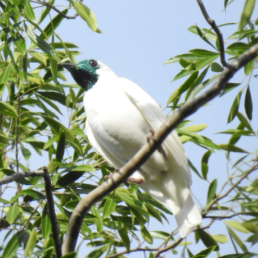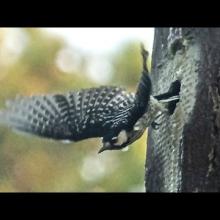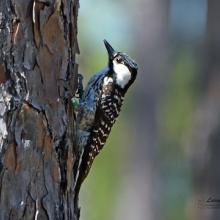

Join BirdNote tomorrow, November 30th!
Illustrator David Sibley and actor H. Jon Benjamin will face off in the bird illustration battle of the century during BirdNote's Year-end Celebration and Auction!
Native to the Southeast across to East Texas, Red-cockaded Woodpeckers differ from most woodpeckers. They remain in cooperative family groups throughout their lives. And they excavate nests in living trees rather than dead ones, often reusing the same cavities for decades. The federal government has listed the Red-cockaded Woodpecker as endangered. Habitat loss is the problem. Most mature pines in the Southeast have been cut down. You can learn more about this and other birds at risk at StateOfTheBirds.org.
BirdNote®
Red-cockaded Woodpecker –
Endangered Bird of Southeastern Forests
Written by Bob Sundstrom
This is BirdNote.
[Dawn chorus including Wood Thrush, Summer Tanager, White-eyed Vireo songs]
It’s just after dawn in the piney woods of Georgia. Suddenly, from out of a hole 40 feet up in a large pine tree, pop four black and white birds. A family of Red-cockaded Woodpeckers is leaving their night roost. [Multiple Red-cockaded Woodpeckers calling105749]
Native to the Southeast, Red-cockaded Woodpeckers differ from most woodpeckers. They remain in cooperative family groups throughout their lives. And they excavate nests in living trees rather than dead ones, often reusing the same cavities for decades. [Sound of Red-cockaded Woodpecker excavating a nest cavity ML128901]
To nest successfully, these woodpeckers need mature, open pine forests — a habitat requirement that has jeopardized their very survival as a species. When John James Audubon walked these woods in the 1830s, the woodpecker was abundant. A century and a half later, the federal government listed the Red-cockaded Woodpecker as endangered. [Multiple Red-cockaded Woodpeckers calling ML 105469]
Habitat loss is the problem. Most mature pines in the Southeast have been cut down. The good habitat that remains is fragmented, and breeding woodpeckers are now isolated in ever smaller gene pools. Better management of federal forests and protection of woodpeckers on private land can slow their decline. But much more needs to be done to ensure the long-term survival of this emblematic bird of the American Southeast.
Learn more at BirdNote.org. I’m Mary McCann. [Multiple Red-cockaded Woodpeckers calling]
###
Calls and sounds of the birds provided by The Macaulay Library at the Cornell Lab of Ornithology, Ithaca, New York. Song of the White-eyed Vireo recorded by G.A. Keller; song of the Summer Tanager by G.A. Keller; Wood Thrush by G.F. Budney; Calls Red-cockaded Woodpeckers calling by G.A. Keller; and Red-cockaded Woodpeckers excavating by Gerrit Vyn.
BirdNote’s theme music was composed and played by Nancy Rumbel and John Kessler.
Producer: John Kessler
Executive Producer: Chris Peterson
© 2015 Tune In to Nature.org July 2015 Narrator: Mary McCann
ID# SotB-RCWO-01-2010-08-15






